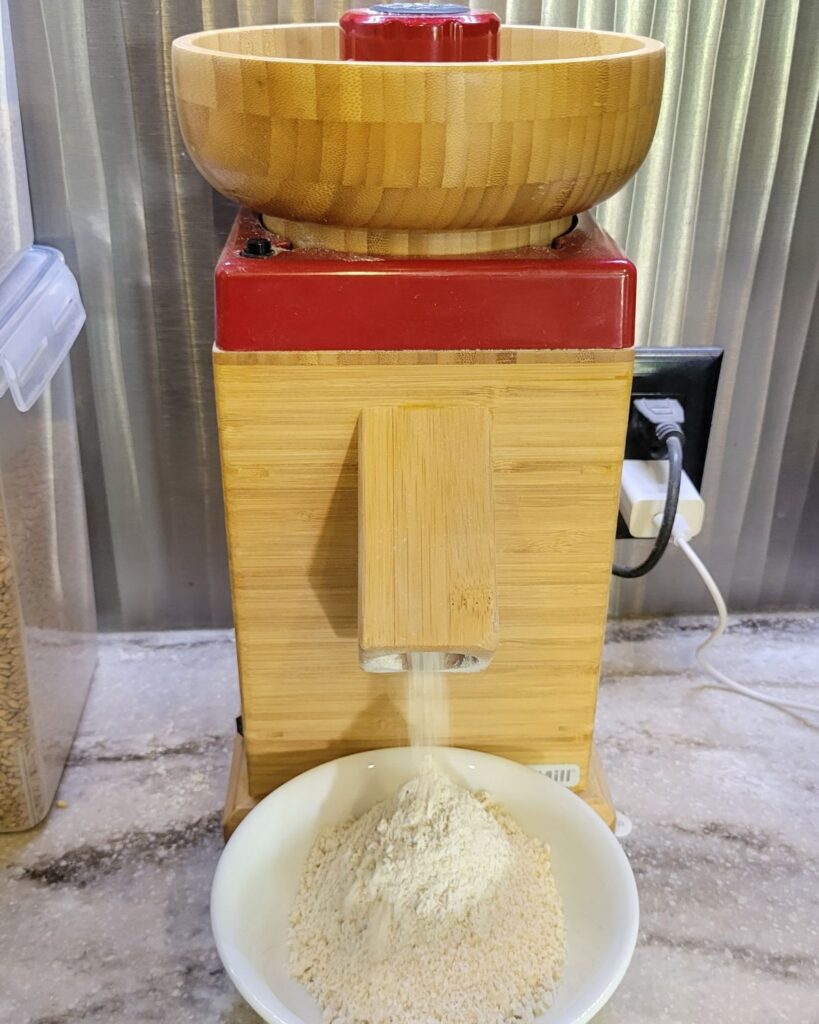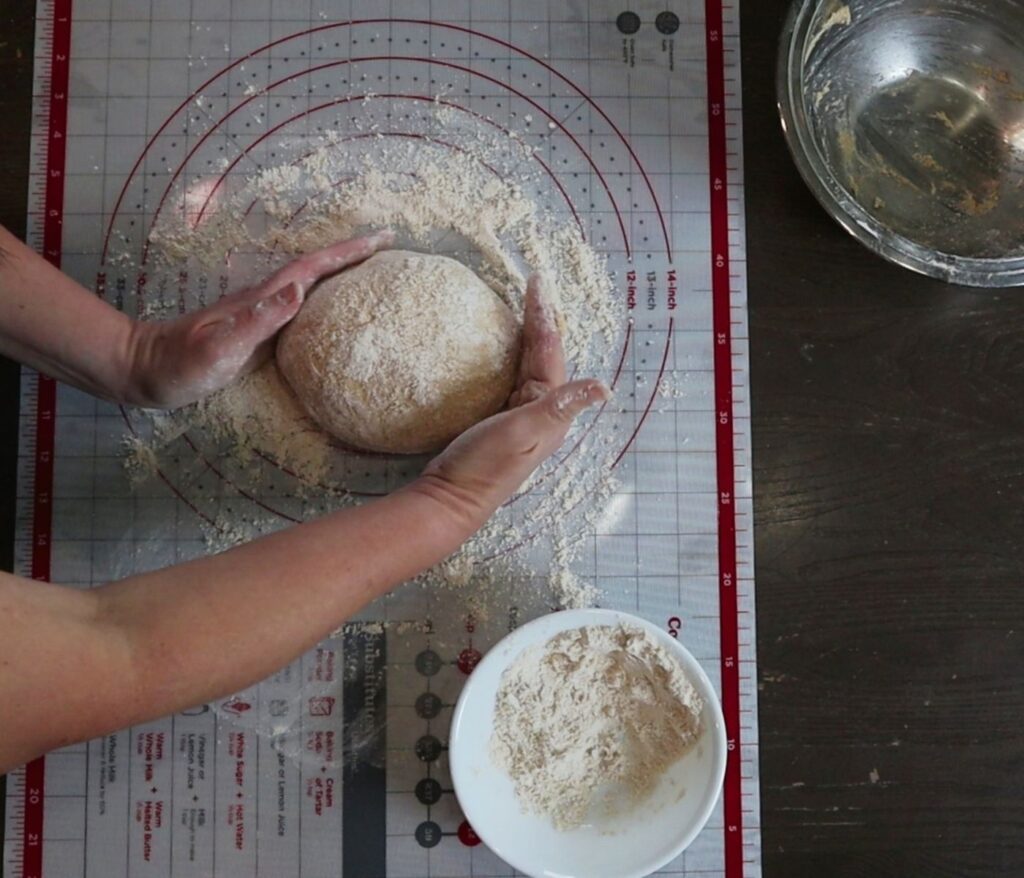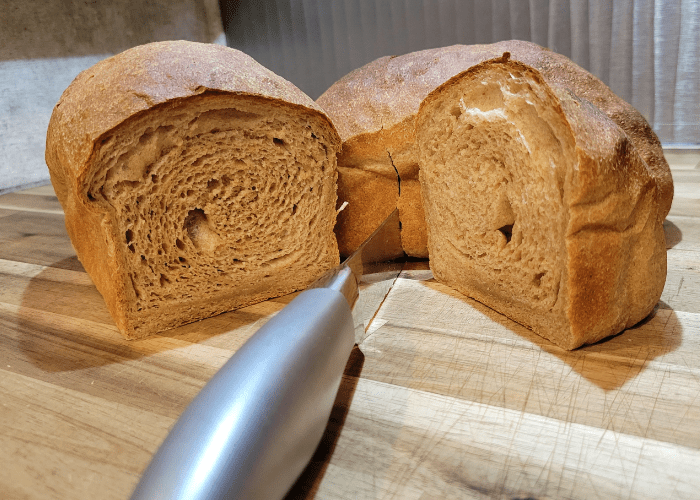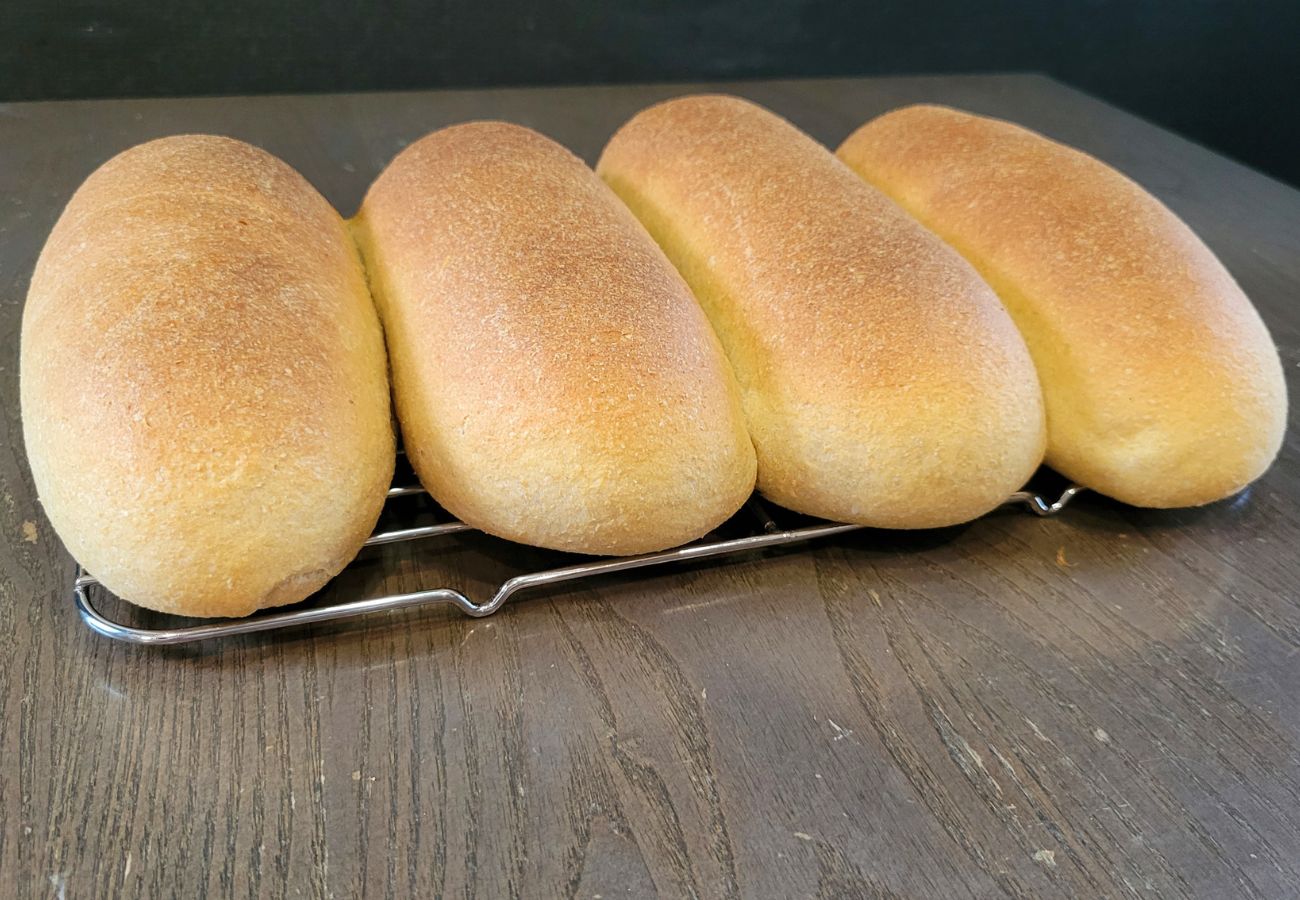Simple No Knead Bread Loaf Made With Fresh Milled Flour
A simple No Knead Artisan Bread Loaf Made With Fresh Milled Flour, yes it can be done. Have you ever dreamed of baking a mouthwatering artisan bread loaf made with fresh milled flour? Well, I have great news for you – it’s not only possible but also surprisingly simple! The best part? You don’t even need sourdough! In this recipe, I’ll show you how to create a magnificent, hands-off bread boule using just a touch of yeast. With a little bit of preparation the night before, you’ll be rewarded with a gorgeously crafted single loaf of artisan-style bread that pairs perfectly with any meal.

How To Make No Knead Bread Using Only Fresh Milled Flour
Working exclusively with fresh milled flour can present certain challenges when it comes to finding the right recipes. After experimenting with various no-knead bread recipes, I’ve discovered a winning formula that delivers consistently outstanding results. I’ve fine-tuned this recipe specifically for fresh milled flour, and I highly recommend using a hard wheat variety like hard white or hard red wheat. While incorporating a small portion of other grains such as Spelt or Kamut is an option, the bulk of the flour should consist of a hard variety that better forms gluten. In this post, I will guide you through the recipe to get a perfect loaf every time!

Understanding The Long Fermentation Process And The Science Behind It
The long fermentation process involved in baking is kind of fascinating how it works. The science behind it is pretty neat, how each organism has a part. During an extended rise period, enzymes, which are naturally present in the flour break down the complex carbohydrates into simple sugars. The wild yeast and lactobacilli thrive in this environment, and they release carbon dioxide gas and lactic acid. This relationship between the microorganisms and the carbohydrates creates a wonderful balance of flavors and textures. As the dough ferments, the lactic acid creates a delightful tang while also enhancing the dough’s texture. Also, the slow fermentation allows for the development of gluten, which is why we can get away with not kneading the dough with this process.

Ingredients For Making No Knead Bread With Fresh Milled Flour
- 3 to 4 cups of fresh milled flour 390g to start (I milled about 2&1/8 cup of hard white wheat to get this amount.)
- 2 tsp salt
- 1/2 tsp yeast
- 1&1/2 cup warm water 350g (90-110*F)
Just those few ingredients mixed together the night before is all it takes to make this delicious bread loaf!

Instructions To Make This No Knead Artisan Bread With Fresh Milled Flour
The Night Before
- Mill Your Flour
- In a large bowl, combine yeast, salt, flour, and water. Mixt these ingredients until combine, the dough will be slightly shaggy (if it is too wet, add a tiny bit more flour.)
- Cover the dough, and let it sit on the counter at room temperature for 12-18 hours (or overnight.)

The Next Morning
- After the dough has sat overnight, move dough out of bowl, and onto a clean, floured surface (I mill a bit more flour for this step, or use any excess from the night before.)
- Then, fold dough edges into the middle, and continue to cup and shape until there is some surface tension, and it creates a tight smooth ball. Also, you should notice the dough holding it’s shape better.
- Line your bowl with parchment paper, and sprinkle a bit of flour on the paper. Make sure the paper is long enough that you can use it as handles to lift the dough out of the bowl.
- Place dough seam side down into the bowl on the floured paper.
- Cover, and allow to rise for 30-40 minutes.
- While the dough is rising, place Dutch oven with lid (or other baking vessel) into the cool oven to preheat.
- Preheat the oven to 450*F with the baking vessel inside.
- Once the dough has risen slightly, and the oven is preheated, then using the parchment paper as handles, transfer the dough into the hot baking vessel. Place lid on, and bake for 35 minutes. *Be careful not to burn yourself!)
- After the 35 minutes, remove the lid, and bake for an additional 10-20 minutes, until the internal temperature reaches 205*F.
- Use the parchment paper handles to remove bread, and place on a wire cooling rack.
- Let bread cool before cutting into it.
- Enjoy!

Shop This Post
My Baking Pan (In lieu of a Dutch Oven)
Checkout Some Of My Other Recipes
Fresh Milled Flour Recipe Index

No Knead Artisan Bread Made With Fresh Milled Flour
Equipment
- 1 dutch oven Or baking vessel with lid that can handle high heat
Ingredients
- 3 to 4 cups Fresh milled flour 390g to start I milled about 2&1/8 cup of hard white wheat to get this amount.
- 2 tsp salt
- 1/2 tsp yeast
- 1&1/2 cup warm water 350g 90-110*F
Instructions
The Night Before
- Mill Your Flour
- In a large bowl, combine yeast, salt, flour, and water. Mix these ingredients until combine, the dough will be slightly shaggy (if it is too wet, add a tiny bit more flour.)
- Cover the dough, and let it sit on the counter at room temperature for 12-18 hours (or overnight.)
The Next Morning
- After the dough has sat overnight, move dough out of bowl, and onto a clean, floured surface (I mill a bit more flour for this step, or use any excess from the night before.)
- Then, fold dough edges into the middle, and continue to cup and shape until there is some surface tension, and it creates a tight smooth ball. Also, you should notice the dough holding it’s shape better.
- Line your bowl with parchment paper, and sprinkle a bit of flour on the paper. Make sure the paper is long enough that you can use it as handles to lift the dough out of the bowl.
- Place dough seam side down into the bowl on the floured paper.
- Cover, and allow to rise for 30-40 minutes.
- While the dough is rising, place Dutch oven with lid (or other baking vessel) into the cool oven to preheat.
- Preheat the oven to 450*F with the baking vessel inside.
- Once the dough has risen slightly, and the oven is preheated, then using the parchment paper as handles, transfer the dough into the hot baking vessel. Place lid on, and bake for 35 minutes. *Be careful not to burn yourself!)
- After the 35 minutes, remove the lid, and bake for an additional 10-20 minutes, until the internal temperature reaches 205*F.
- Use the parchment paper handles to remove bread, and place on a wire cooling rack.
- Let bread cool before cutting into it.
- Enjoy!
Video
*This post contains affiliate links, which means I make a small commission at no extra cost to you! As an Amazon Associate I earn from qualifying purchases. But, I will only suggest items I actually Love and Have Used!









It’s so nice to have someone figuring out the ratios for fresh milled flour!
Thank you for all your recipes!
My pleasure! I am so happy it is helpful! Thank you!
Dude, it’s been a trip trying to bake sourdough out of fresh milled. I’ve made so many nasty loaves but learned a ton. So grateful for your recipes. You are bomb!!!!
I am so happy to hear that! Yes! I too struggled for quite some time, and I just kept experimenting and playing with techniques and recipes, until this one finally produced nice loafs! Thank you!
Am I missing something? I would love to make this recipe with sourdough starter instead of yeast. Is this possible? Thanks!
I do have a sourdough boule recipe as well! https://grainsinsmallplaces.net/sourdough-fresh-milled-flour-easy/
Thank you for this recipe. I wonder though, if I added sugar or honey for taste, would that change anything?
It would sweeten it up a bit, let me know if you give it a try! 😊
Hello! I’ve made this recipe once and it turned out delicious! I was wondering if you’ve ever cold proofed this dough after the 1st rise? I’d like to ferment mine during the day then put it in the fridge overnight to bake tomorrow.
Hi, I think that would work just fine! Let me know how it turns out! Happy Baking!
I’m so new to this but I know that fermenting food is good for digestion. So, how did it work for you and how did you do it?
Thanks
My whole family has felt better ever since switching to fresh milled flour. I think how is better answered by my videos. I have a lot to get you started, and tons of recipes too! Happy Baking! https://youtu.be/MuyHiOaBqYQ?si=uiw0ORJTStackz1L
Made my first loaf tonight with hard white and it was delicious. If I want to try another type of wheat with the hard white (like kamut) what ratio would you recommend? I know the video says a majority of the hard variety what would be best? Also if I wanted to try hard red would I just do a half hard red and half hard white?
Thanks!!
You can do half hard red and half hard white or any ratio of those two. For the Kamut, I like to keep it about 75-80% hard white or hard red, and 20-25% Kamut. Let me know which ratio you like best! Happy Baking
Is instant yeast ok to use with this recipe?
Yes, I use instant yeast in almost all my yeast breads! Let me know how you like it! Happy Baking!
I made this using 100% kamut grain with an added 3 tbs of vital wheat gluten. It tasted ammmmmazing!!! Almost like popcorn! I didn’t get the oven spring I was hoping for as I accidentally added too much instant yeast but I still got a rise and it tasted great so, it’s not a loss imo. I’m going to try again with less yeast on my next loaf. I love the 100% kamut flavour beyond measure and I’m determined to get it right! Thank you for giving me a diving off point!
Yay! I love Kamut too! I think it has a lovely flavor, and great texture. I also have a 100% Kamut sandwich bread if interested. You can also add vital wheat gluten to that as well if you prefer. https://grainsinsmallplaces.net/kamut-bread/
Do you by chance know how much berries to use if I’d want to make this using einkorn?
I would use the same weight amount for Einkorn. Let me know how it turns out! Happy Baking!
I absolutely love this recipe. I found it to be very easy to put together even on a busy day. I used a new brand of pink Himalayan sea salt for the recipe, though, and I shouldn’t have. This bread is so salty! I never in a million years would have thought one brand of salt could be saltier than another. Ahh well, live and learn! This will be good with egg sandwiches, and that’s what I was hoping for. 🙂 Can you tell me any tricks to get the bottom of the boule to be as easy to cut as the rest? The bottom crust came out very hard! TIA
Thank you so much! Yes, it is crazy how some salt can be more salty than others, especially if it is very fine powdered. To had the bottom not be so crusty, you can move the oven rack up one, or place an empty baking sheet on the rack just below the loaf. I hope that helps! Happy Baking!
Thank you so much – I’m making another batch tonight, halving the salt and raising the rack up a notch. I love the texture of this bread, and it’s working fine for making an egg sandwich (with no salt on the egg). This is so good!
Yay! Keep going, until you find the perfect technique! I love that! Thanks!
I haven’t tried this yet, but wanted to confirm the yeast amount … only 1/2 teaspoon?? Seems so little yeast. Please confirm. Thanks!
Yes, this is a very small amount, because this is such a slow overnight rise. Let me know how it goes! Happy Baking!
I love this bread. ❤️
Will be making this regularly
Yay! I am so happy you enjoyed it! It is so nice to have a recipe to just throw together the night before, and bake the day you want it! Thanks so much!
We’re able to get hard red spring, red fife, and soft white freshly milled flours where we live. Would it work to use either hard red spring or red fife mixed with soft white? Hubby prefers white bread over whole wheat.
Out of those options, I would recommend a hard red or red fife for breads. They will be able to form gluten to make the stretchy dough, soft white won’t form gluten, so you would only be able to use a small amount of that mixed with mostly hard red. Like 85% hard and 15% soft white. If your hubby prefers white bread, you may want to look into hard white. I like to also add some Kamut (Khorasan Wheat) to it for a lighter bread. I hope that helps!
Thank you so much! I haven’t been able to find a local source of freshly milled hard white or kamut yet but will try your suggestions in the meantime.
Yes, Kamut especially can be tricky to source.
Soft white is actually out of stock so I wasn’t able to order it but I did source some pre-milled Einkorn. Could I use that with hard red or red fife? If so, what ratios?
You could use mostly hard wheat with Einkorn, I would say 80% hard wheat and 20% Einkorn. Let me know how it turns out! Happy Baking!
Wow, I want to try this! I don’t have a Dutch oven, could this bread be made in loaf pans? I have regular 9 x 5 pans and 9 x 4 Pullman pans. Would I need to make any changes to the steps if so? Thank you 🙂
You could make it in a bread pan, this will make one 9×5 loaf. It won’t have the crusty exterior without the steam, which is what the Dutch oven helps keep in. But, still yummy! Let me know what you think! Happy Baking!
Hi just doing the next mornings rise. The water in recipe above says 390g but i dont think thats right, so just dud the cups could you put the correct ml measure please as i like to use my digital scale for accuracy. Thx for the recipe.
The water in the recipe should be 350g, the flour is 390g.
Turned out nice, just a bit salty. Maybe my wife did heaping teaspoons, not sure.
Im going to try 1.5 tsp salt next time.
Let me know how it goes next time!
How do you find it best to store this vread? Plastic bread bags or fabric bags?
I like to let me bread cool completely, then slice and place in freezer safe bags or containers, then freeze. I find it keeps them the freshest the longest.
I am on the mission field in Mexico, so I am without a mill or a scale for measuring, but I do have a coffee grinder that I am using for grinding. I’ll be making this bread this morning and baking it in a toaster oven.
What I am most pleased about is that there are only a few ingredients, and it makes this a possibility to use and share in ministry to the poor. There are several malnourished adult and children in the little village we serve. I’m mulling over in my mind how to teach and provide this resource into these homes – some without electricity or running water. Your recipe just may make this a possibility. Reading the positive comments left by others fills me with hope.
I am so happy to have found your recipe ~ complete with conversions! Thank you!!!
Awesome! That is wonderful of you to share and teach others! I am so happy to hear this recipe will be helpful! Thank you so much! I am sure all of those people will feel blessed! 😊
How would you adapt this to make a pizza dough?
Pizza dough needs to be a little more of a loose dough, so maybe increase the liquid, but I have a wonderful pizza dough for fresh milled flour as well if you haven’t given it a try yet. https://grainsinsmallplaces.net/pizza-dough-fresh-milled-flour/
Is there a reason you don’t score the bread before baking? I’ve always scored my boules, but I haven’t tried making one with freshly milled flour yet!
I do sometimes, it’s just preference and what mood I am in, lol. 🙂
Could walnuts and craisins be added to the dough? I would also add some liquid stevia, which I’ve had success with in making a sweeter bread in my bread machine with FMF.
Yes, you can add mix-ins. I am unsure about the liquid stevia as I have not tried that, but I would assume it would be ok in there! Let me know how it goes! Happy Baking! 🙂
Can I use Active Dry Yeast in this Artisan bread recipe? If so how much? I’ve tried Rapid Rise and ADY in my bread maker and both times I got a crater in the top… If you have suggestions for the bread maker I could use some guidance there too. I’m looking forward to trying a new Dutch Oven for this recipe. 😋
Yes, you can use active dry yeast. Just activate it first with some of the liquid from the recipe and a pinch of sugar. When it is nice and foamy (10-15mins) then put it in and mix. If there is a crater on the top, it sounds like your bread is over proofing. I would try to shorten the second rise time. I hope that helps! 🙂
What kind of yeast do you use/recommend? Instant? Active Dry? Something else?
I used to use all instant yeast, but someone pointed out to me that a lot of the instant yeast has some additives. So, lately I have been using active dry yeast and checking for no additives.
Does this method lessen the phytic acid of the grain?
Felicia shares some good info on phytic acid here, it may help. https://youtu.be/APoMIGAWNJY?si=ZRKsuw8Sm4tUR9aQ
I’m new to bread baking and fresh milled flour. I just finished making this bread – mixed emotions. The raw dough did get the air bubbles and did increase in size somewhat, but after forming the ball and resting about 25 minutes then baking the bread did not increase or rise at all. The fermentation period started last night, so I would say about 14 hours. We live in the Pacific Northwest (south western region) and our house is kept at 66 degrees. Would that temperature have anything to do with the process. Just wondering if I should put my dough inside my oven overnight (not on, of course)? Trying to see if a warmer environment is necessary.
It may have been because it was too cold, or could be a yeast issue. I would recommend taking some of the yeast, and putting it in warm water with a pinch of sugar, after about 10-15 minutes it should get nice and foamy. If not, then the yeast may be going bad. Also, make sure the water was not too hot that was added to the bread recipe, as that can also kill off some or all of the yeast.
Kara, your recipes ALWAYS are a success. I’m getting ready to make your No Knead Artisan Bread recipe for the first time. I saw in the comments where you said add ins would be fine. I’d like to add walnuts and dates. Do I do that when I mix the dough or in the morning when I shape it for the oven?
Thank you for all you do to make FMF baking a joy!
P.S. Yesterday I made your cheese crackers. Oh my! They are delicious.
Yay! I am so happy to hear that! Yes, you can do add-ins with this recipe. For walnuts and dates, I would put them in during shaping before baking. Let me know how it goes! Happy baking! (I would try to gently flatten the dough by stretching (not pushing all the air out.) then put your add-ins on top of the dough sheet. fold one side towards the middle, then meet that with the other side in the middle sprinkle a bit more mix-ins on, then roll up and shape.) I hope that makes sense.
Your directions for the add-ins makes perfect sense. Thank you! I was eager to try the recipe, so I made it without add-ins. Delicious! Now that I have your instructions, I’m going to make it with dates and walnuts. I’ll let you know how that turns out.
Awesome! Let me know how it goes! 🙂
I did it! I made your no knead bread with dates and walnuts! It’s so utterly delicious my husband and I had to force ourselves to stop eating it. I added 2 Tbsp. of organic brown sugar. I let it ferment the full 18 hours. And I baked it in my 9” Pullman pan. Next I’m going to try dried apricots and almonds. This might be my new favorite bread recipe. I love your Honey Oat Bread, and I’ve made many loaves of bread from your sweet dinner roll recipe—and dozens of dinner rolls. Along with many of your other recipes. But this is so easy. Thank you for this great recipe!
Awesome! I am so happy to hear that! Thanks for the flavor ideas, they sound delicious! 🙂
When you baked the bread in your Pullman pan, did you use the lid?